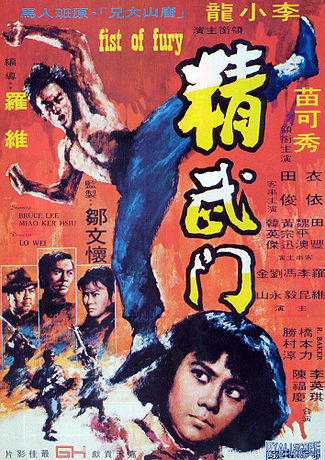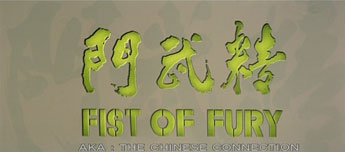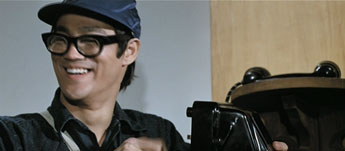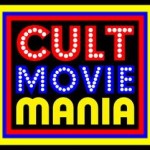Sweetback is enamored with Bruce Lee’s
furious fists

Ok, first a bit of a history lesson. We all know Bruce Lee was King Shit of Fuck Mountain when it came to international kung-fu movie success, and that he died suddenly at the age of 32 immediately before the release of Enter The Dragon – a film that cemented his place as a force in American films. Despite his enduring legacy, Lee only really made 4 1/2 films in his lifetime: The Big Boss (Tang shan da xiong) (1971), Fist of Fury (1972), The Way of the Dragon (Meng long guo jiang) (1972), Enter the Dragon (1973), and was filming what became Game of Death (unreleased until 1978) when he passed away.
Now, as is often the case with an international phenomenon, North America was late to the party when it came to loving Bruce. He may have stolen the show on The Green Hornet (as Kato), but his Chinese films had spotty distribution, and were re-titled (and dubbed) for a Western audience, making things a little confusing. The Big Boss was originally going to be retitled The Chinese Connection (to capitalize on the recent success of William Friedkin’s The French Connection) for the U.S., but instead got renamed Fists of Fury, which makes things really confusing since (the real) Fist of Fury ended up being released as The Chinese Connection. This is likely because in many US markets, Fist of Fury/The Chinese Connection started appearing first, despite actually being made later.
Got that? Clear as mud? Well, it’s about to get muddier.

For many, Fist of Fury was their introduction to Bruce Lee as a cinematic (and physical) force, and to call it a revelation would be a vast understatement. This shit blew minds. How influential was it? Well, let’s see: New Fist of Fury (starring Jackie Chan!) arrived in 1976, Fist of Fury II (starring Bruceploitation star Bruce Li) came in 1977 and Fist of Fury III (/w Bruce Li, and also known as Fist of Fury II and The Chinese Connection III) showed up in 1979. But, we’re just getting started! Fist of Fury was re-made as the incredible Fist of Legend (starring Jet Li) in 1994, and had a mini-series (sort of) adaptation (called Fist of Fury) starring Donnie Yen, which came out in 1995. An edited version of this mini-series was later released on DVD. Oh, and Yen made a sequel to both his mini-series AND the original Fist of Fury with Legend of the Fist: The Return of Chen Zhen in 2010! There have also been countless parodies: Stephen Chow made Fist of Fury 1991, and followed it up with Fist of Fury 1991 II (1992), and tributes like Kill Bill (2003) and IP Man (2008). They just keep coming.
But what’s the big deal? Sure, Bruce Lee had charisma to spare and was fast as fuck, but what makes this particular film so inspiring?
It’s actually the Chinese nationalism and – most prominently- anti-Japanese sentiment which runs through the whole thing. Bruce Lee isn’t just playing the fictional Chen Zhen, he’s playing a student of the real-life kung-fu legend Huo Yuanjia (himself immortalized in films like Jet Li’s Fearless (2006) and Yuen Woo-ping’s Legend of a Fighter (1982)) and is based on Liu Zhensheng, Yuanjia’s actual student. Like Wong Fei-Hung before him, Chen Zhen goes from being an actual person to becoming a folk hero who fights against injustice in all its forms. But Zhen doesn’t just beat his opponents, he demolishes them. He leaves entire rooms bloodied and broken. He even outright kills! Japanese/Chinese relations have been strained for a long time, and the portrayal of the Japanese here is reminiscent of the sort of propaganda common in North America during World War II. It’s over the top – the characters are all cartoonishly evil and abusive towards the serene and peace-loving Chinese – but very effective in raising Chinese national pride.

But what about the plot? Bruce Lee is Chen Zhen, a young student returning to Shanghai in the early 20th century (when there was a huge Japanese population in the city) in order to marry his fiancee, but discovers that the master at the Jing Wu martial arts school, Huo Yuanjia, has passed away suddenly. Insult is added to injury by the sudden appearance of two students from the local Japanese Bushido school, who bring with them a sign for the Jing Wu school calling them “Sick Men of East Asia.” Needless to say, this makes Chen super-fucking pissed, but he’s told to calm himself since the school preaches the idea of non-violence.
This self-restraint lasts for about five minutes before Chen Zhen heads over to the Bushido school and demolishes everyone. He kicks them in the face, tosses them like (literal) rag-dolls, and then nunchucks their heads, before making the students eat the sign (which he brought along for kicks). This might very well be *the* prototypical Bruce Lee fight, with his opponents circling him before ineffectively striking, and it’s so much fun it should be illegal. In fact, let’s watch:
But Chen isn’t finished! On his way home, he wanders by a park with a sign that states “No dogs and Chinese allowed.” As you may imagine, this makes him super pissed, a feeling that is exacerbated by some Japanese folks who wander by and suggest he act like a dog in order to get in. I don’t want to spoil anything, but Chen Zhen once again beats the living hell out of any Japanese face that wanders into his view, which further draws the ire of the populace. The Japanese dojo responds by heading to the Jing Wu school and smashing it (and its students) to bits, demanding they deliver Chen Zhen to them. The Jing Wu students (eventually) decide to help Chen leave Shanghai to avoid arrest.
Chen agrees, and is getting ready to leave when he overhears a conversation between the Jing Wu cook and caretaker stating that they – per the instructions of the Japanese – poisoned his master. If you’re guessing that he responds with MASSIVE AMOUNTS OF RAGE, then you have been paying attention. This time, though, he actually kills both men and hangs them from a streetlight. Discovering the plot was hatched by a traitorous Chinese translator, Chen disguises himself as a rickshaw driver, before beating a confession out of him. Oh, and he kills him too! Does he hang him from a streetlight? Yes, he does.

The Japanese are rightfully a bit peeved about Chen’s rampant serial killing, and decide to respond in kind by sending the (non-crippled) members of the dojo to massacre the Jing Wu students. Chen, now addicted to wearing funny disguises, heads over to the near-empty dojo to kill anyone left breathing. This includes a Russian strongman named Petrov who, after a few early successes, ends up – you guessed it – really dead. This leaves just Chen and Suzuki, the evil Japanese master. Suzuki pulls out a katana and.. it doesn’t end well for him. Soon thereafter, Chen Zhen discovers that pretty much everyone from both schools have been killed and, after receiving a promise that the school will continue, decides to give himself up. It ends with him running throwing a flying kick at a group of armed soldiers – just like Butch and Sundance!

Sure, the plot is a bit over the top, but this is really the quintessential Bruce Lee movie. He looks great, goes through a plethora of emotions (from bottled rage to unleashed rage) and convincingly pummels his opponents into little piles of goo. None of it is particularly stylish – director Lo Wei (who also directed The Big Boss, and would eventually attempt to unsuccessfully launch Jackie Chan a few years later) stages things with aplomb, but it’s all a bit flat looking. Thankfully, the set pieces are so good that they more than make up for the rather iffy requisite romantic subplot, or lengthy scenes of characters looking for Chen Zhen, or watching geisha dancers, or whatever. Bruce is the whole show here, and everything is designed to make him a God in the eyes of the world.
Don’t believe me? Check out the trailer. “Also sprach Zarathustra” playing behind scenes of Bruce kicking ass, while the text in front sings his praises (“Bruce Lee is on the warpath again!”) – nobody can ask for more than that! Watching Fist of Fury just highlights how much of a loss to the industry Lee’s death truly was. His charisma still crackles onscreen, and he obviously had the philosophy and creativity to find great success in the US. Instead, it really wasn’t until the 1990s, with the rise of Jackie Chan and Jet Li (and later with the success of Crouching Tiger, Hidden Dragon), that movie executives finally clued in that audiences will flock to see quality martial arts (and other!) movies with Asian leads.
Still, Fist of Fury is ground zero for many kung-fu fans, and it holds up startlingly well. The fights might lack the acrobatic choreography or colorful photography of the Shaw Brothers efforts of that time, but there’s a grittiness and speed to the action that is absolutely exhilarating. Certain scenes – the dojo fight, the smashing of the sign, the flying kick to the camera – have become legendary, but despite the numerous imitations and recreations, they’ve lost little of their power. If you’re looking for a film that fully captures the extraordinary Bruce Lee at his most impressive, this is it.
NEXT WEEK: DRUNKEN MASTER (Jui kuen) (1978)
Sweetback
LOOKING FOR UNDERGROUND CULT MOVIES, DVDs, LIMITED VHS & OTHER COOL STUFF.
CHECK OUT THE DAILY GRINDHOUSE/CULT MOVIE MANIA STORE
- [THE BIG QUESTION] WHAT’S YOUR FAVORITE FEMALE ENSEMBLE IN MOVIES? - July 22, 2016
- [IN THEATERS NOW] THE BOY (2016) - January 24, 2016
- Cult Movie Mania Releases Lucio Fulci Limited Edition VHS Sets - January 5, 2016






No Comments